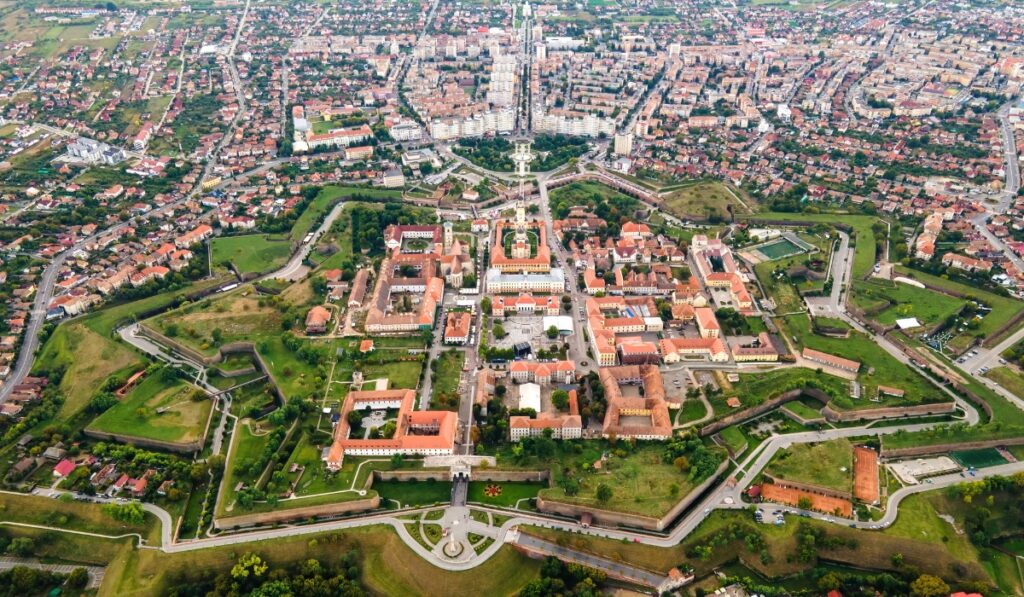This post may contain affiliate links. At no cost to you, purchases made through these links may result in a small commission for Traveling Transylvania. We never recommend products that we don’t know and trust. Thank you for your continued support!
Have you ever dreamt of journeying through a realm where history tangibly embraces the present, whisking you into tales of valor, majesty, and ancient splendor? Welcome to the Citadel of Alba Iulia. From the moment you set foot within its regal boundaries, you’re not merely walking—you’re tracing the steps of countless souls who’ve shaped the pages of Transylvania’s history.
But the Citadel isn’t just about stony ramparts and weathered battlements. Every brick, every arch, every shadowed corner narrates an epic. Roman helmets? Witnessed. Medieval knights? They’ve paraded here. A plethora of tales that make your heart race as you wander? Assuredly so. Every path promises revelations, ensuring that history is not just seen but deeply felt.
As you immerse in this ancient tapestry, let the whispers of bygone eras guide you. From the strategic genius behind the fortress’ design to the festivals that once echoed within its walls, Alba Iulia beckons with an allure that’s both nostalgic and exhilarating.
Whether you’re here to relive history, marvel at architectural prowess, or simply breathe in the essence of Transylvania, the Citadel of Alba Iulia is your portal to a mesmerizing voyage back in time. Prepare to be entranced.
- Practical Information for the Citadel of Alba Iulia
- An Extensive History of Alba Carolina Citadel
- Visiting the Citadel: A Whirlwind of Wonder
- Dive Deeper in Alba Iulia: More Than Just A Citadel
- The Road to Alba Iulia: Your Adventure Begins Here
- Where to Stay in Alba Iulia
- Conclusion: A Love Letter to Alba Iulia
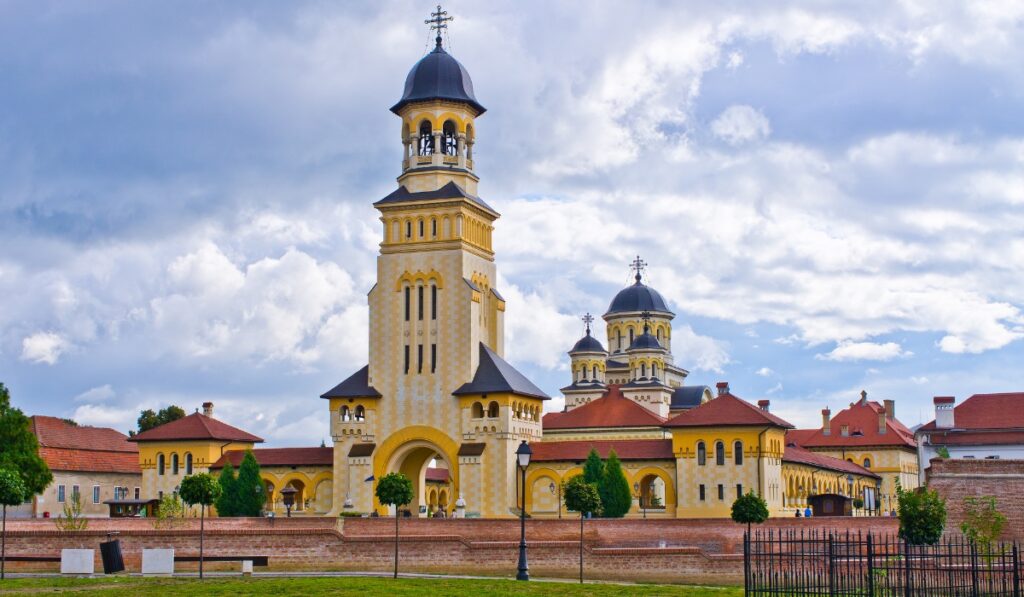
Practical Information for the Citadel of Alba Iulia
Address:
Hidden amidst Transylvanian landscapes, where history blends with nature, you’ll find the Citadel at: Calea Moților, Numărul 5A, Alba Iulia
Website:
For those who prefer to embark on a digital reconnaissance before stepping into the realms of history:
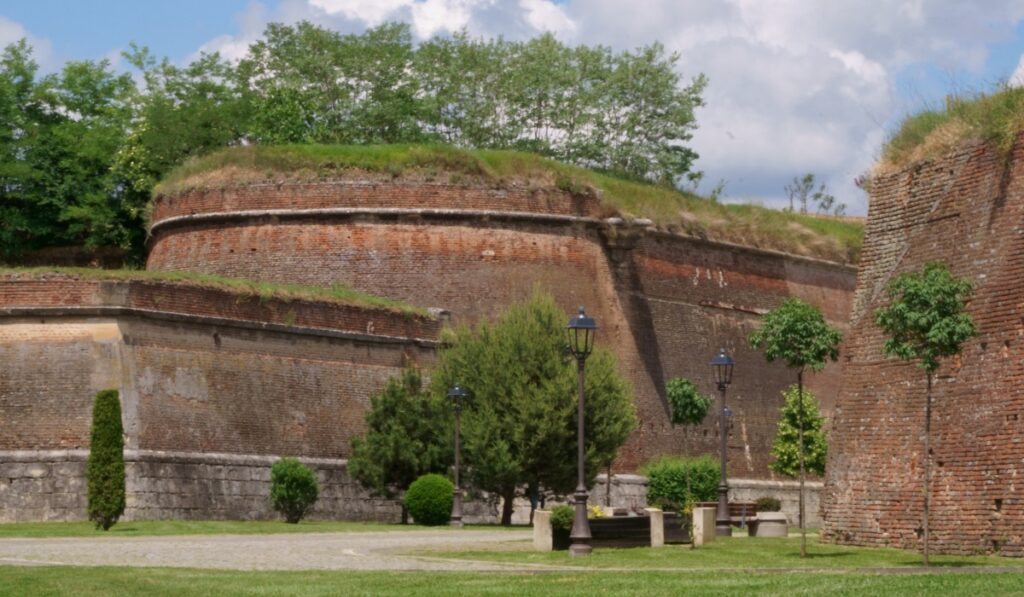
An Extensive History of Alba Carolina Citadel
Origins: Foundations in Antiquity
Before the Romans etched their indelible mark on this land, the Citadel’s region echoed with the valorous chants of the Dacians, a proud and ancient people. With their fortresses high in the Carpathian Mountains and their intricate gold and silver craftsmanship, they were the true children of this terrain, having called it home since around the 1st millennium BC.
However, as destiny would have it, in the early years of the 2nd century AD, the landscape of this region was poised for change. Emperor Trajan, with his eagle-eyed ambition and Rome’s indomitable legions, set his sights on Dacia. The allure? Its vast gold and silver reserves. By 106 AD, after two brutal wars, the Dacians were vanquished, and Dacia was annexed into the sprawling Roman Empire.
Amidst the spoils of this conquest arose Apulum. Positioned strategically, this Roman establishment wasn’t a mere military outpost but soon burgeoned into one of the largest and most prosperous cities in Roman Dacia. Serving as a nexus for trade, culture, and military strategy, it reflected Rome’s classic architectural and urban genius. Amphitheaters, forums, and temples sprouted, giving birth to a unique blend of Roman-Dacian culture.
Apulum was more than just bricks and mortar. It was where Rome’s grandeur met Dacia’s resilience, creating an enduring legacy. Every column, every stone, every path was a testament to a time when emperors dreamt, legions marched, and two cultures intertwined to script a narrative that the Citadel of Alba Iulia still whispers today.
This region, imbued with the spirits of warriors, traders, and architects of yore, beckons with tales of might, ambition, and fusion. As one ventures through the Citadel, it’s this primordial allure that resonates, forming the foundation of the rich tapestry that is Alba Iulia’s storied past.
Medieval Majesty: Rise of the Fortress
As the grip of the Roman Empire waned, the Dacian land underwent another metamorphosis. The foundation laid by Apulum still whispered its tales, but new voices were soon to join this ancient chorus.
In the wake of the Roman retreat, various migratory tribes made their mark here, from the Huns to the Gepids, and later the Avars and Slavs. These footprints, though transient, layered the region with diverse influences. However, it was during the Middle Ages, particularly from the 9th century onward, that the true renaissance of this area as a formidable citadel began.
By the 10th century, the Hungarian conquest of the Carpathian Basin introduced a new era. The citadel region caught the eye of the Magyar leaders for its strategic importance. Voivode Gyula, a Hungarian tribal chieftain, was particularly smitten. Recognizing its significance as both a bastion and a beacon of power, he made the citadel his residence, laying the foundation for its medieval resurgence.
Under Hungarian rule, the citadel was continually fortified and expanded. Gothic architecture began to rise, casting long, poetic shadows over the land. Churches, like the stunning St. Michael’s Cathedral, sprung up, bearing silent testimony to the era’s religious fervor and architectural prowess.
But it wasn’t just a time of brick and stone; it was an age of parchment and ink. Chronicles penned during this era, such as the Gesta Hungarorum, immortalized the citadel’s significance. Wars, alliances, betrayals, and tales of chivalry echoed within its walls, with figures like Matthias Corvinus, the renowned King of Hungary and Croatia, playing pivotal roles.
By the end of the Middle Ages, the Citadel of Alba Iulia had transformed from a Roman legacy to a living, breathing emblem of medieval grandeur.
Habsburg Reign and Architectural Marvels
As the tendrils of the Middle Ages receded, the dawn of the Early Modern Period saw a new power looming on the horizon: the Habsburg Empire. This Austro-Hungarian dynasty, known for its vast territories and political acumen, coveted the strategic gem that was the Citadel of Alba Iulia.
The 18th century, in particular, became a defining era. The Habsburgs, not ones to leave things to chance, recognized the necessity of a fortification that could withstand both time and treachery. And so, in the early 1700s, they embarked on an ambitious project to redesign and reinforce the Citadel.
Italian architect Giovanni Morando Visconti was chosen for this herculean task. Drawing inspiration from the military architectural genius Sébastien Le Prestre de Vauban, Visconti envisioned a star-shaped fortress, with bastions named after saints. The design was not only about aesthetic grandeur but also about ensuring strategic dominance.
Each of the seven bastions, christened with names like Saint Stephen, Saint Michael, and Saint Capistrano, were fortified entities of their own. Deep moats surrounded them, intricate tunnels wove between them, and watchtowers overlooked them. This architectural marvel was designed to make any adversary think twice.
But it wasn’t all war and strategy. The Habsburgs also infused Alba Iulia with cultural and religious significance. The Baroque-styled Batthyaneum Library, founded by Bishop Ignác Batthyány, became a beacon of knowledge, housing ancient manuscripts and incunabula. The Union Hall and the Roman Catholic Cathedral further solidified the citadel’s reputation as a hub of spirituality and enlightenment.
This era also bore witness to revolts, power plays, and the quest for autonomy. The Citadel, while a symbol of Habsburg authority, also echoed with the aspirations of those yearning for self-determination.
The Great Union: A Land United
The ripples of World War I were felt far and wide, tearing apart old empires and setting the stage for new beginnings. At the heart of Eastern Europe, a dream was taking shape, a vision of unity for all Romanians. And the Citadel of Alba Iulia was destined to become its epicenter.
The backdrop was set in 1918, in a world weary of war and seeking solace in new futures. For Romanians spread across different regions, it was a moment of reckoning, a clarion call to unite as one. The idea was profound yet simple: bring together territories with significant Romanian populations, like Transylvania, Banat, Bessarabia, and Bukovina, under a single banner.
On the crisp day of December 1st the Alba Iulia National Assembly convened within the citadel’s historic walls. Delegates from different Romanian regions congregated, hearts heavy with hope and anticipation. It was here that they ratified the union of Transylvania with the Kingdom of Romania.
King Ferdinand and Queen Marie of Romania, figures of great resonance during this epoch, became the symbols of this newly united nation. Their coronation, particularly Queen Marie’s, as she was the first queen to be crowned in Alba Iulia, infused the citadel with an aura of royalty and national pride.
However, the Union was not just about political maneuverings and royal endorsements. It was the manifestation of a collective Romanian spirit. Folk dances, traditional songs, and heartfelt poetry marked the celebrations. The citadel resonated with joy, optimism, and an overwhelming sense of togetherness.
Modern Times: Resilience and Rebirth
In the aftermath of the Great Union, the 20th century unfurled a tapestry of events that were both tumultuous and transformative. The Citadel of Alba Iulia, standing tall through centuries, would bear witness to the pulse of modern Romania.
World War II & Post-War Period: With the world once again plunged into conflict, Romania’s own geopolitical position was in flux. The Citadel, with its history of military significance, could not remain just a bystander. As the tides of war ebbed and flowed, the fortress saw movements of troops, shelters, and strategic consultations.
Yet, the true seismic shift came in the post-war years. The rise of the Communist regime in Romania brought forth changes that echoed through every brick and archway of the Citadel. As the nation was swept up in the fervor of socialist ideology, the fortress, symbolic of Romania’s feudal and bourgeois past, faced a period of neglect.
The Revival in the Late 20th Century: However, like the phoenix, the Citadel was destined to rise from its ashes. The fall of the Communist regime in 1989 ushered in a new dawn, one that recognized the importance of heritage, history, and identity. The Citadel of Alba Iulia began its renaissance, as both the government and the people endeavored to restore its former grandeur.
21st Century & Beyond: Entering the 21st century, the Citadel embraced the digital age. Interactive tours, augmented reality experiences, and comprehensive online resources transformed the way visitors experienced Alba Iulia’s rich past.
The Citadel of Alba Iulia, having braved the ebbs and flows of time, stands today not just as a relic of bygone eras but as a living testament to Romania’s resilience, evolution, and undying spirit.
Preservation: Echoing Eternity
In the grand theater of history, structures like the Citadel of Alba Iulia don’t merely stand; they narrate, inspire, and educate. Yet, time, while being a storyteller, can also be an eroder. The magic lies in preservation, the art and science of ensuring that the soul of such edifices remains undiminished.
Recognizing the Need: As the 20th century progressed, it became evident that the citadel, with its layers of history, was showing signs of wear. Weathered stones, crumbling bastions, and fading frescoes cried out for attention. The clamor for restoration, especially post the Communist era, was not just about bricks and mortar, but about reclaiming national pride and identity.
Sustainability in Focus: The Citadel’s preservation wasn’t just about looking to the past, but also preparing for the future. Eco-friendly materials, sustainable renovation techniques, and efforts to reduce the carbon footprint were incorporated. This ensured that the Citadel, while a symbol of bygone eras, was also a model for future conservation efforts.
Global Acknowledgment: Owing to its comprehensive and detailed preservation initiatives, the Citadel of Alba Iulia began receiving recognition not just nationally but internationally. Historians, architects, and travelers lauded the efforts, placing the Citadel as a benchmark in the annals of architectural conservation.
Today, the Citadel stands, not as a mere relic but as a glowing testament to what dedicated preservation can achieve. It’s a bridge between yesteryears and tomorrow, ensuring that while centuries pass, stories remain, waiting to be heard, felt, and cherished.
Visiting the Citadel: A Whirlwind of Wonder
Oh, dear traveler, have you ever yearned to tread on cobblestones that whisper tales of yore? To wander through alleys where every nook seems to beckon with a secret? If tales of knights, poignant love stories, and dashing escapades quicken your pulse, then visiting the Citadel of Alba Iulia promises an affair to remember.
Wandering and Wondering: Let your curiosity be your guide. Each gate of the Citadel, ornate and imposing, welcomes you to a world where history romances the present. Whether you fancy a leisurely stroll beneath ancient archways or want to challenge yourself with a spirited climb up the bastions, there’s a narrative awaiting at every turn.
Dress for Time Travel: Given that you’re about to prance through epochs, it’s essential to be comfortable. Think breezy linens, sun hats, and trusty sneakers. While the Citadel appreciates modern couture, do remember you’re stepping onto medieval grounds; heels might find it a tad… challenging.
Become a Story Hunter: The Citadel is teeming with legends, some recorded, others whispered only by the winds. Engage with local guides, the true keepers of the Citadel’s soul. With stories tucked up their sleeves, they’ll regale you with tales of bravery, intrigue, and timeless romance.
Savor a Bite of the Past: Beyond history, the Citadel offers gastronomical journeys. Discover quaint cafes and eateries that serve dishes inspired by ages gone by. From medieval roasts to Transylvanian treats, let your taste buds waltz through time.
Capturing Moments: In this digital age, no visit is complete without photographs. The Citadel, with its juxtaposition of ancient stone against the vivid Romanian skies, offers backdrops that would make any Instagram feed swoon with envy. So, click away, but remember – sometimes, the best memories are the ones etched in the heart.
Stepping into the Citadel of Alba Iulia is akin to opening a book where every page brims with adventure, allure, and awe. In this historic haven, time doesn’t just tell stories; it invites you to live them. So, come, let the Citadel sweep you off your feet and into the embrace of epochs past.
Dive Deeper in Alba Iulia: More Than Just A Citadel
Batthyaneum Library: Imagine stepping into a realm where ancient manuscripts and astronomical instruments hold court. Established by Bishop Ignác Batthyány, this Baroque-style building is more than a library; it’s a repository of centuries-old secrets. Peruse texts that date back to the early Christian era and indulge in a literary journey like no other.
Unification Cathedral: A harmonious blend of architecture and spirituality, this cathedral is a celebration of the Great Union of 1918. With its imposing spires and intricate interiors, it’s not just a place of worship but an artistic testament to Romania’s vibrant history.
The Roman Catholic Cathedral: A journey through time, this cathedral showcases the Gothic architectural splendor of the 13th century. Tales of faith, battles, and resilience echo through its walls. And if you’re fortunate, the hauntingly beautiful strains of the organ might just transport you to another era.
The National Museum of Unification: Here’s where the past comes alive with vivid detail! This museum takes you on a curated journey through Romania’s evolution, from prehistoric times to the modern era. Its interactive exhibits and rich collections make history a thrilling adventure.
Astra Park: Need a breather? The tranquility of Astra Park is the perfect antidote to a day of exploration. Stroll by its serene lakes, engage in bird-watching, or simply lie back and let the Romanian sky regale you with its ever-changing hues.
Alba Iulia’s Night Watch: Dive into tradition! Every evening, as twilight descends, a guard-changing ceremony reminiscent of medieval rituals takes place at the Citadel’s gates. With guards in period costumes and a theatrical flair to the proceedings, it’s a spectacle that melds tradition with entertainment.
Dine at La Cetate: For those gastronomic adventurers, this restaurant within the fortress walls offers a blend of Romanian culinary traditions with modern twists. Imagine savoring Transylvanian sausages in a setting where knights and royalty once dined!
Alba Iulia, with its blend of history, culture, and natural beauty, offers myriad experiences that promise to linger in memory long after the journey has ended. So, step out, explore, and let this Romanian gem weave its magic around you.
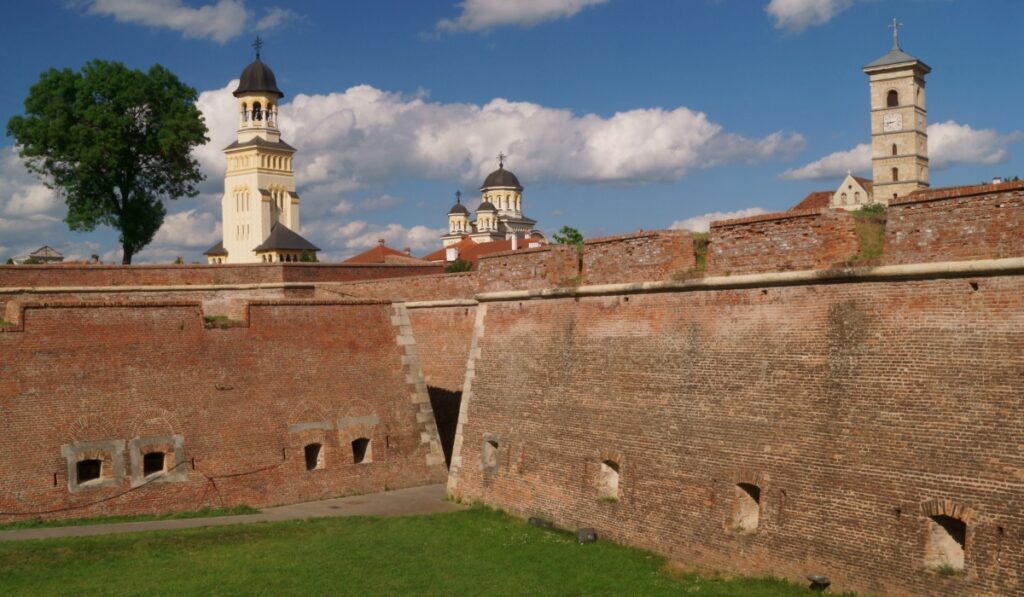
The Road to Alba Iulia: Your Adventure Begins Here
Setting foot in Alba Iulia feels like stepping into a fairy tale, but every magical journey has its own beginning. Whether you’re zooming down the highway, or hopping on a train while the Romanian countryside blurs by, the anticipation of reaching this historic jewel only adds to the thrill.
From Sibiu:
By Car: Like a breeze over the Carpathians, it’s a swift 1-hour drive (about 70km) on the E81. As you weave through picturesque landscapes, imagine the tales the trees might tell if they could talk.
By Public Transport: The train offers a comfortable 2-hour journey, allowing you to relax as the world outside flits by, each passing landscape like a page from a storybook.
From Sighișoara:
By Car: Embark on a 1.5-hour drive (around 90km) via the DN14. Picture medieval merchants traversing the same route, laden with tales and goods.
By Public Transport: The train ride, taking about 2 hours, offers a moment of respite, a prelude to the historical adventures awaiting in Alba Iulia.
From Brasov:
By Car: A journey of approximately 2.5 hours (around 200km) via the E68 awaits. With the mountains as your backdrop, it’s a drive drenched in scenic beauty and allure.
By Public Transport: Cozy up for a 3 to 4-hour train ride. As the train chugs along, dream of citadels, legends, and the upcoming exploration.
From Bucharest:
By Car: Embark on a majestic 5-hour drive (about 330km) via the A1 and E81. This route is your overture, setting the stage for the historic splendors of Alba Iulia.
By Public Transport: Settle into a train journey that spans around 6 to 7 hours. This elongated prelude to Alba Iulia allows you ample time to muse about the adventures that lie ahead.
From Cluj-Napoca:
By Car: A relatively short 2-hour drive (around 100km) on the E60 transports you from the urban rhythms of Cluj-Napoca to the historical heartbeat of Alba Iulia.
By Public Transport: The train offers a breezy 2 to 3-hour journey. As the cities fade and the countryside emerges, let the anticipation build.
Whichever route you choose, remember: the journey to Alba Iulia is not just about reaching a destination; it’s about embracing every moment, every landscape, and every heartbeat of excitement that carries you closer to the Citadel’s embrace.
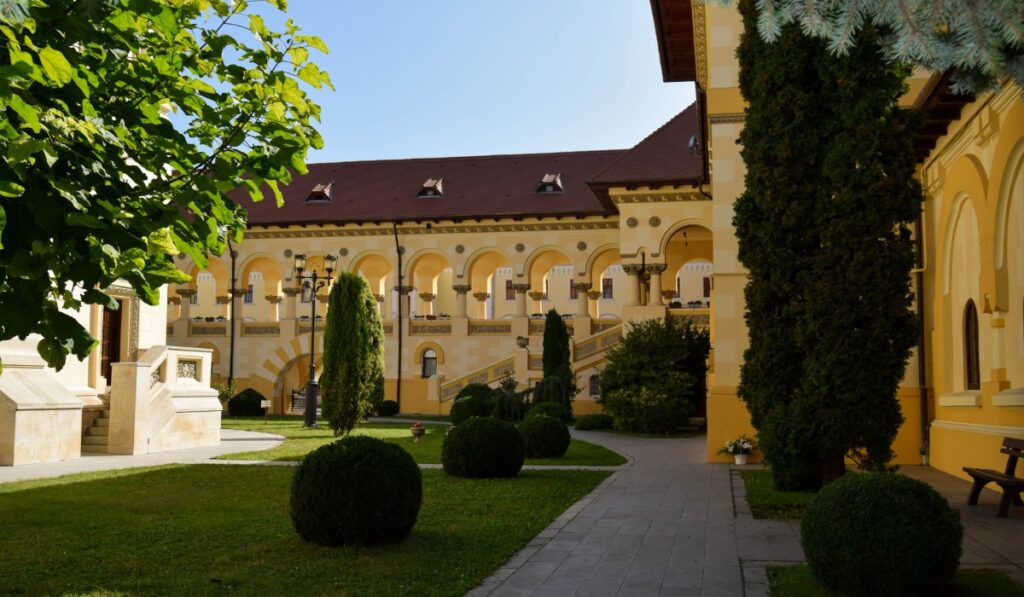
Where to Stay in Alba Iulia
In a city that’s drenched in history and magic, your choice of stay can add another layer to your Alba Iulia tale. Whether you’re a budget traveler looking for a snug corner or someone with a penchant for opulence, Alba Iulia offers a dwelling just right for your story.
Budget Delights: A Cozy Haven for the Thrifty Traveler
Hotel Medieval: Nestled in the city’s heart, this charming inn offers comfort without burning a hole in your pocket. With its rustic decor, it’s like you’ve traveled back to simpler times, but with all the modern amenities at your disposal.
Hostel Citadel: Perfect for backpackers and solo travelers, this hostel is a stone’s throw from the Citadel. Relive your day’s adventures with fellow travelers in the cozy common room.
Midrange Magic: Perfect Blend of Comfort & Elegance
Vila Preciosa: A perfect amalgamation of elegance and comfort, Vila Preciosa stands out with its modern amenities set in classic decor. Located close to the city’s main attractions, it ensures that the heart of Alba Iulia is never too far.
Hotel Transilvania: Steeped in history, this hotel offers a touch of Transylvanian charm with its quaint architecture and warm hospitality. Enjoy your evenings in the ambient hotel restaurant after a day of exploration.
Luxe Lodgings: For Those Who Desire the Royal Treatment
Castel Haller: Nestled on the outskirts of Alba Iulia, this opulent hotel screams luxury. Once a baronial mansion, it now opens its grand doors to travelers. With gourmet dining, sprawling gardens, and rooms fit for royalty, you’re in for a regal treat.
La Maison de Caroline: Immerse yourself in luxury at this boutique hotel located in the heart of the city. With its French-inspired decor, plush rooms, and world-class amenities, every moment here feels like a pampered embrace.
Whichever abode you choose, remember: your stay in Alba Iulia is an integral part of the tale. From budget nooks to luxurious chambers, each offers its own unique flavor to your Transylvanian adventure.
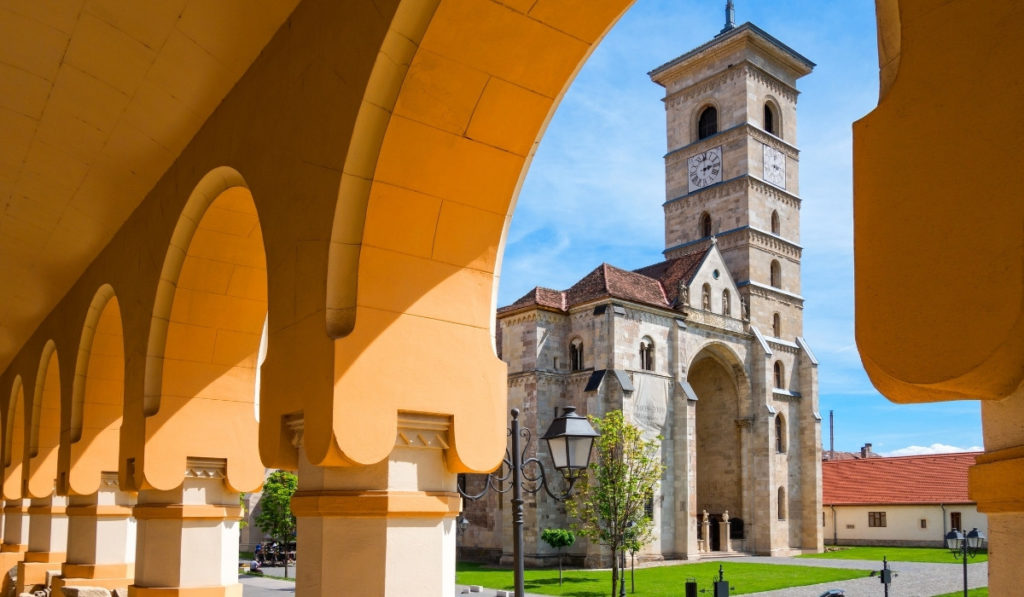
Conclusion: A Love Letter to Alba Iulia
In the tapestry of travel tales, Alba Iulia emerges as that enchanting thread which, once unraveled, leads to countless stories, legends, and experiences. From the whispers of ancient stones to the bustling life beyond the Citadel’s walls, every moment here feels like a rendezvous with history.
You might come for the tales of bravery, the architectural marvels, or perhaps the simple allure of Transylvania. But what will undoubtedly linger is the feeling of having journeyed through time. A dance between the epochs, if you will, with every step echoing tales of yore.
To choose Alba Iulia is to choose more than just a destination. It’s to embrace a living story, to become a part of its narrative, and to leave with a piece of it echoing in your heart.
And as you tread beyond its boundaries, with memories of cobblestone paths and stories of knights and nobility, know this: Alba Iulia, in all its historic glory and contemporary charm, will always beckon for another rendezvous. A call to relive the magic, to unearth more tales, and to fall in love with it all over again.
So, dear traveler, until our paths cross again in the heart of Transylvania, carry Alba Iulia with you. Let its tales be the stories you regale, its spirit the zest in your adventures, and its memory the compass that guides you back.

